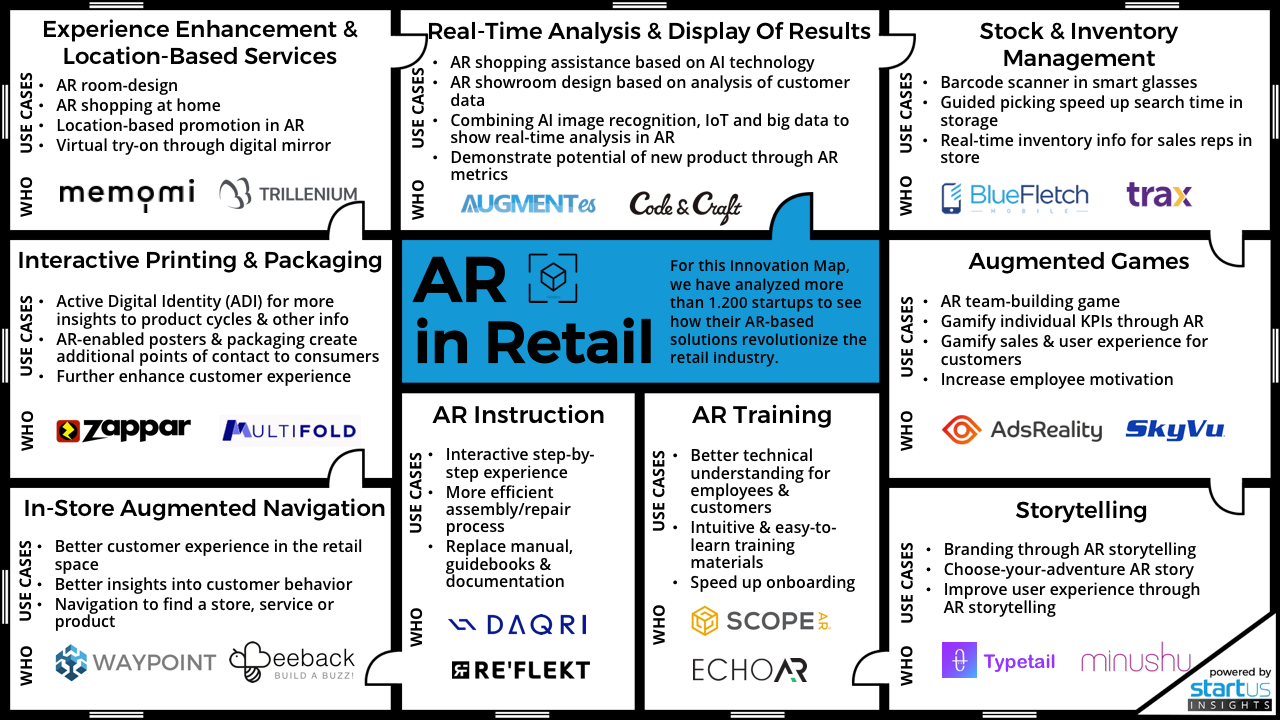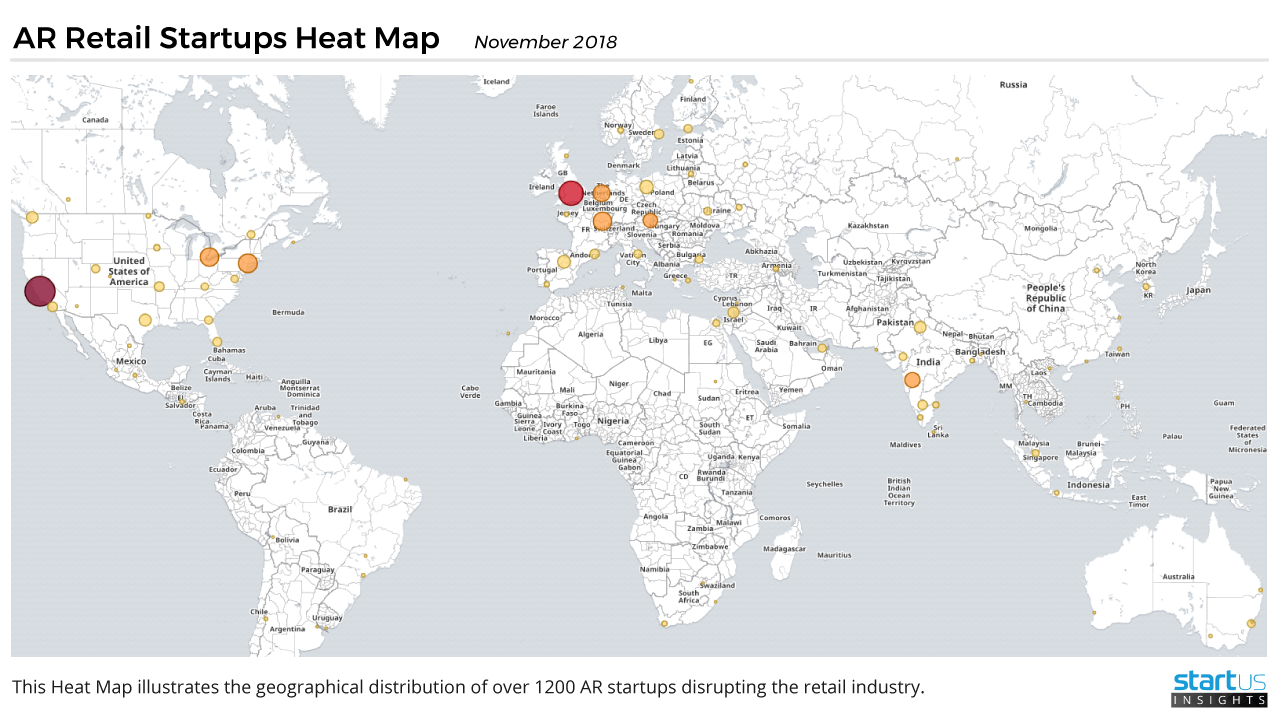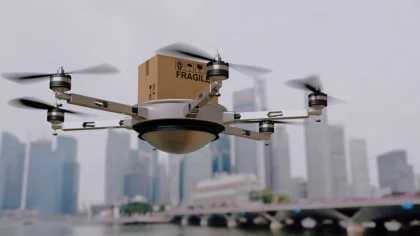Key Takeaways
Augmented reality transforms nearly every aspect and process in the retail industry today, from the supply chain and inventory management and back-end processes to customer-facing solutions thus enhancing the interaction with (potential) customers.
In Summary, Augmented Reality
- rewrites the industry’s rules and norms by creating another dimension of company-customer communication
- positions and promotes retailer’s products, values, and goals
- communicates retailer’s message to customers in a more efficient, friendly, human-like and innovative way, thereby engaging and educating them
- is crucial for retailers to implement in order to survive in a highly competitive environment
- equips retailers with the information they need to stay agile, gain competitive advantage and promote better decision-making
As augmented reality (AR) innovations are quickly becoming widespread, the retail industry is one of the pioneers in exploring and applying this technology to stay ahead of their competition, grow their business and create new channels for communication with customers.
Nearly 75% of consumers expect retailers to develop and implement AR experiences into their businesses. The customer’s desirability of using AR far exceeds other technologies such as virtual reality (VR) or artificial intelligence (AI). At StartUs Insights, our Innovation Analysts carried out an extensive research on augmented reality’s prospects in the retail industry to assist companies in gaining a competitive advantage and exploring application areas for this technology.
Below is a list of major use-cases in retail operations that are being improved by the use of AR in today’s companies, which allows them to keep up with the digital transformation of the industry.
Augmented Reality In Retail – The Innovation Map
Augmented Games (Gamification)
Similar to the way the immensely popular Pokémon GO had taken over the world of gaming, AR, in general, is crafting gamified experience across a range of sectors and industries, which facilitates better results and drive organizational development.
In retail, its most obvious applications are for salespeople. Top performers of a company are rewarded with extra points, by a special bonus system in the form of scoreboards and other game-like elements that react to objects or actions amongst other features.
AR can also be used to create real-world enhanced scenarios and tie the reward system to the way how each employee reacts in different situations. Overall, the utilization of AR in terms of gamification for training and rewarding also reduces unpleasant situations and safety problems, while increasing employee morale and engagement.
Storytelling
Another impressive application of AR in retail is its use as a primary storytelling medium for marketers to build a strong brand and raise customer awareness. Generally speaking, it is rather a unification of many AR capabilities to ensure consistent interaction with clients and potential customers. Ranging from gamification to providing additional product information, which eases the shopping experience and helps customers along the way.
AR is potent enough to be used in all of these activities, from gamifying the customer experience to providing more personalized product-related information within stores through the usage of AR headsets or mobile devices. Needless to say that a successful retailer would see a positive response both in terms of product demand and ROI.
Interactive Printing & Packaging
The retail, product, and packaging industries are seeing dynamic change through the use of innovative AR technologies. Positively affecting both supply chain efficiencies on the enterprise side and the opportunity for more active and engaging retailer marketing initiatives in-store, on-the-go and at home.
AR solutions for printing & packaging of goods and clothing, among others, benefit the retail industry in a number of ways. Using existing static packaging, a retailer can create a separate point of contact with its customers by literally representing the brand’s storefront. Stores for children use AR for developing custom-branded mini-games for their young target audience and promoting other products, thus driving sales.
External packaging with AR capabilities, on the other hand, gives retailers more room for additional information regarding their products’ unique selling points, production process, quality standards, thereby increasing consumer awareness and serving as a separate, viable sales channel.
Notably, such AR-enhanced packaging and printing materials can be used for the gamification of the in-store and online shopping experience, creating various quests for customers and allowing them to collect a certain amount of codes for future discounts, and much more.
Beyond the interactive and social capabilities of AR packaging and printing, brands have the capability of creating their products’ so-called Active Digital Identity (ADI).
ADI allows companies to monitor the life-cycle of their products, initiating and processing product recalls, enhancing inventory management, and, overall, gathering massive amounts of additional data to be further analyzed. The gathered data combined with AI and machine learning leads to better decision-making both for a retailer’s strategy and its operations.
In-Store Augmented Navigation
The usage of AR technology for providing better navigation guidance in the real world is really quite natural. Particularly in retail, it is of interest both when it comes to in-store and street navigation.
When shopping at large retailers, it is sometimes just too exhausting to find the right product a customer is looking for, especially when they are not sure about the brand and the product’s specific set of features they want to buy.
While being connected to a store’s inventory availability system, AR comes in handy by giving customers overlaid real-world environment instructions on where exactly, in which row and which shelf the product or product category is located, along with the complementary goods that are used with it.
Ultimately, augmented navigation makes it easier to find and buy retail products, helping sellers realize their inventory more quickly and enhancing the shopping experience, thus attracting even more customers.
Experience Enhancement & Location-Based Services
The enhancement of the customer experience has always been one of the main priorities of any retailer. Augmented reality in mobile devices, represents an innovative and effective way of raising the bar when it comes to creating the perfect shopping experience. Use cases are plentiful, including virtual try-on of clothing and makeup, by using AR-capable digital mirrors, for instance.
AR also aids in providing useful additional product information right from the shelves when a customer points their smartphone at a certain product – this includes information about complementary products, videos of the production process, interactive advertising and much more.
Home furnishing retailers, for example, also extensively implement AR technology by letting their customers superimpose their products (beds, tables or other furniture) onto their private home environment to make sure they are a good fit.
Instructions
Retail businesses are using AR to support their customers, especially when it comes to the assembly of products. IKEA and Lego, for example, are already experimenting with giving their customers interactive step-by-step manuals on the assembly of home furniture and models respectively. AR instructions are a game changer when it comes to the ease of buying and assembling products.
Real-Time Analysis & Display Of Results
An impressive example of a complex AR-based system usage is represented by Maggy London International, which implemented a sophisticated AR tool utilizing Apple’s AR-kit to create a 3D lifelike online showroom experience through an AR product catalog.
It goes even further by integrating with the company’s enterprise resource planning (ERP) system, which allows monitoring customers preferences, giving insights to performance and popularity metrics of certain products, feedback of buyers and much more in real-time.
All of this, essentially brings significant value to a business, not only by just showcasing the innovativeness of a firm and industry but also by reducing the cost of selling products and shortening the sales cycle.
Stock & Inventory Management
Augmented Reality tools ensure better and more advanced stock & inventory management. More specifically, AR engages warehouses workers in the so-called “vision” or “guided” picking, which helps them find the exact location of a certain package/product and highlights it for easier pinpoint process and pickup.
AR-guided picking helps warehouse employees navigate towards needed supplies and make the overall process order-picking much faster and more efficient. In retail, AR is mostly used in this way for the supply & enterprise side of the industry.
AR Retail Startups Heat Map
The Heat Map below illustrates the geographical distribution of over 1.200 AR startups disrupting the retail industry. The United States and the United Kingdom are taking the lead. For more insights into the distribution check out our AR Retail Startups Heat Map:
AR Startups Disrupting The Retail Industry Include:
- ZappAR – Through its mobile app and tAR headset (ZapBox), the startup designs, creates and deploys custom-tailored AR products ranging from interactive packaging to education and sports content for large companies.
- Trillenium – Its AR platform allows customers to see how different shoes will fit and suit them before buying. This is achieved by pointing an AR-enabled smartphone with their app at one’s feet and choosing the right model.
- Memomi – Provides a high-fidelity, true-vision digital imaging software platform. Memomi is a digital mirror for in-store AR-enhanced shopping. Customers can try on various outfits and compare their looks on them side-by-side by just looking at a seemingly regular mirror.
- Trax – Focuses on retail in-store management solutions that are AR-enhanced and allow for better inventory/stock management as well as restocking shelves and maintaining warehouses serving retailers.
- Daqri – Empowering workforces to be more effective. DAQRI Worksense™ and DAQRI Smart Glasses® link digital content to the real world to accelerate productivity, communication, and key business processes.
- Code and Craft – Transforms the way fashion and retail industries sell and showcase products around the world by producing photo-realistic content that can be rendered in VR, AR, and Web 3D experiences.
- Augment – Provides brands with an augmented reality platform to help pitch their in-store displays and promotions to retailers. For example, B2B sales reps for consumer brands can use the platform to pitch their vending machines or merchandise displays to department stores.
Augmented reality is not just improving existing retail operations, it is re-writing the industry’s rules and norms by creating another dimension of company-client communication. Implementing augmented reality solutions into their businesses is becoming crucial for retailers to survive in a highly competitive environment. To gain a competitive advantage and promote better decision-making, it is vital for retailers to understand the great potential of augmented reality thus equipping them with the information they need to stay agile.










